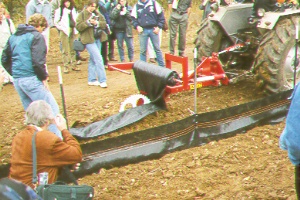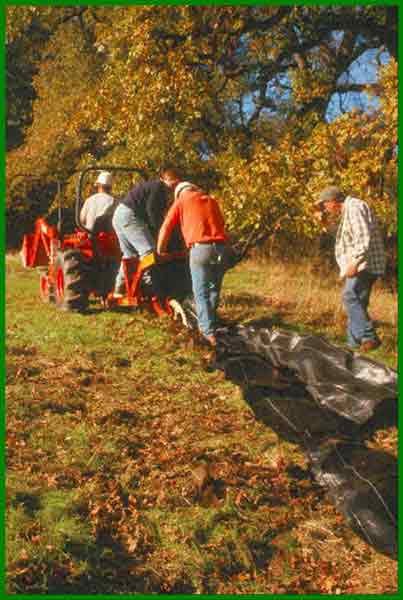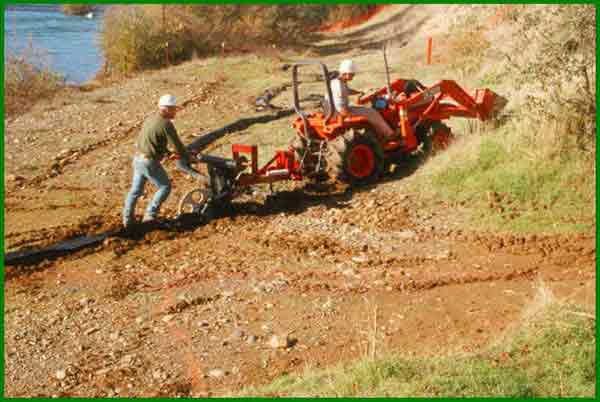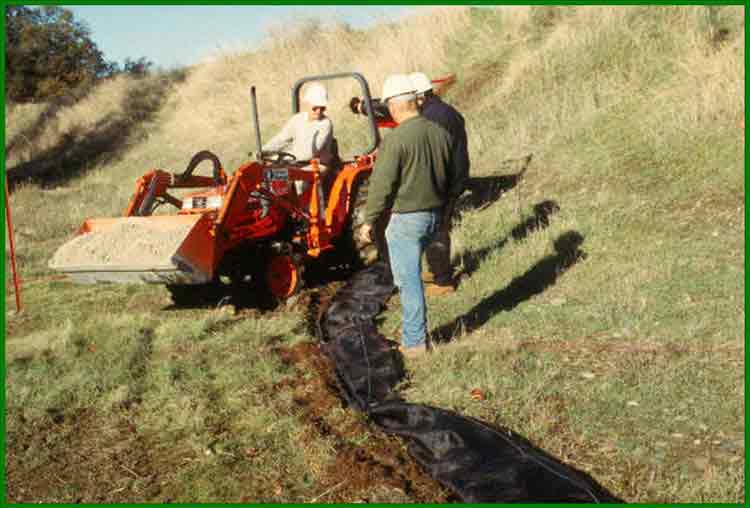Definition:
A silt fence is a temporary sediment barrier consisting of filter fabric
entrenched into the soil and attached to supporting posts. Silt fence
installed with a trencher or by slicing is the most effective installation
method to ensure against common silt fence failures.
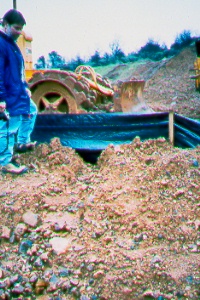
The slicing method for silt fence installation utilizes an implement towed
behind a tractor to “plow” or slice the silt fence material into the soil.
The slicing method requires the “Tommy” silt fence machine or equivalent.
Silt fence machines install the silt fence by slicing through the soil, rather
than excavating it. Slicing minimally disrupts the soil upward and
slightly displaces the soil, maintaining the soil’s profile and creating an
optimal condition for future mechanical compaction. Compacted soil resists
water infiltration and moisture saturation, thus nearly eliminating washouts.
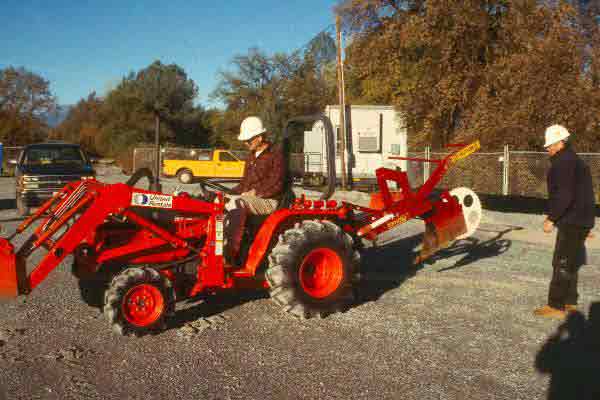
Purpose: Silt fence is a sediment control practice. Silt fence
is intended to be installed where sediment-laden water can pond, thus allowing
the sediment to fall out of suspension and separate from the runoff.
It is not intended to be an erosion control practice. Improperly applied
or installed silt fence will increase erosion. Reasons for the
high failure rate of improperly designed and installed silt fence include:
- Improper placement on the site;
- Allowing excessive drainage area to the silt fence structure;
- Shallow trenches with little or no soil compaction;
- Inadequate attachment to posts;
- Failure to maintain the silt fence after installation;
- Installing silt fence along property boundaries producing
"concentrated" runoff.
|
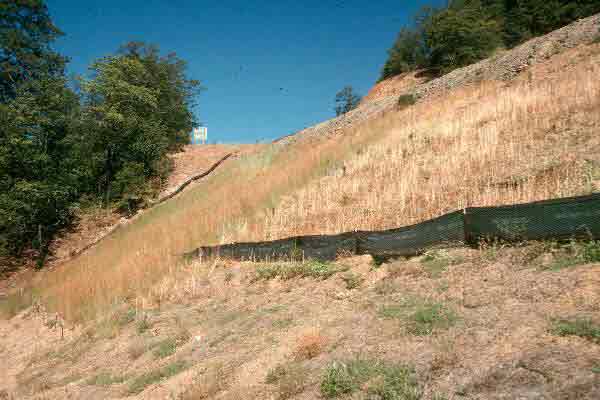
Improper installation on slopes causes gullies
|
Silt fence must only be installed where water can pond.
When placed off contour, silt fence will effectively divert runoff if that
is desired.
Silt fence can be used where:
- sheet and rill erosion would occur;
- protection of adjacent property or areas beyond
the limits of grading is needed (perimeter control);
- the size of the drainage area is no more than
1/4 acre per 100 linear feet of silt fence;
- the maximum flow path length above the barrier
is 100 feet (30.5 m);
- the maximum slope gradient above the barrier
is 2:1;
- small swales are carrying silt, the slope is
less than 2%, and the drainage area is less than 2 acres (0.8 ha);
- no practice other than a silt fence is feasible.
|
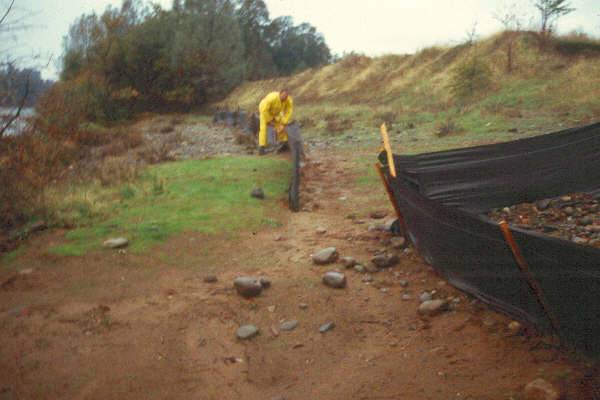
This silt fence was not keyed in and is improperly
placed.
|
Design Considerations:
Silt fences have a useful life of one season. Their principal mode
of action is to slow and pond the water and allow soil particles to settle.
Silt fences are not designed to withstand high heads of water, and therefore
should be located where only shallow pools can form. Their use is limited
to situations in which sheet or overland flows are expected. Install
silt fences with smiles.
The slicing method has the capability to turn in a short distance, thus
properly installing silt fence where needed. Turning enables upturns
on the ends of silt fence runs, maneuvering around obstacles on construction
sites, protection along property lines, and following contours.
Silt fences normally cannot filter the volumes generated by channel flows.
When installed across a concentrated flow path, undercutting of the fence
often occurs. Silt fences should not be designed to impound sediment
or water more than 18 inches (0.5 m) high. Sediment shall be cleaned
from behind the fence when it reaches 50% of the designed impoundment height
(9 inch (0.2 m)).
Some design considerations include:
- determine what kind of runoff, and how much, is coming onto the
site; too much volume of water per silt fence area means failure will happen;
- determine where and how the total volume is going to exit; total
drainage area is the prime consideration of silt fence quantity, not necessarily
slope;
- soil type can play a role in the placement and quantity requirements;
sandy soils might require more silt fence per area to contain the volume
of potential sediment; clay soils might need fewer fences because the volume
of potential sediment loss is less, although the volume of water might be
greater because clay soils allow less rainfall infiltration;
- type, size and spacing of fence posts; wood posts are inadequate
and should not be used; steel t-posts weighing at least 1.25 lbs per ft.
are required, as they can be driven 24 inches into compacted soil, which
is necessary to hold a horizontal load 18 inches high, and they can also
be recycled and used repetitively; improper spacing of posts causes failures;
- type of filter cloth; if all the elements of the silt fence installation
are properly adhered to, the fabric does not make much difference; even
lightweight non-woven fabric will hold 18 inches of sediment; wire supported
fence is costly and ineffective.
|
These silt fences were not properly keyed into
the soil.
|
Construction Specifications:
Typical silt fence specifications were written 25 years ago and have changed
little since. Some states have recognized some of the inherent problems,
such as inadequate trench depth, and implemented minor changes to improve
efficacy. The 25 year-old specifications, referred to as the trenching
method, have never been tested for efficacy and proven worthwhile.
A trencher was simply the only piece of equipment available at the time capable
of securing the fabric into the soil, regardless of efficacy.
Proper installation of silt fence using the "slicing"
method.
Today, many contractors just open a furrow with a blade and backfill onto
the fabric with the crumbs. Loose soil, either from the trencher or
the blade, absorbs water quickly and becomes saturated easily, washing out
under the fabric.
- The soil should be sliced and the fabric mechanically installed
into the soil
- The height of a silt fence shall not exceed 36 inches (0.9 m).
Storage height and ponding height shall never exceed 18 inches (0.5 m).
- To minimize erosion, install silt fence at the head of a slope to
slow velocity and to create a large storage area.
- The fence line shall follow the contour as closely as possible.
- The ends of the fence should be turned uphill.
- Steel support posts should be utilized, properly spaced and driven
into compacted soil
- Post spacing shall not exceed 6 feet (1.8 m).
- The filter fabric is stapled or wired directly to the posts. Filter
fabric shall not be stapled to existing trees.
- Fabric should be attached to the posts with three diagonal ties
- Silt fences placed at the toe of a slope shall be set at least 6
feet (1.8 m) from the toe in order to increase ponding volume.
Installation of Silt Fence with Smiles
Page 2 
(Installation
and Maintenance)
(Typical
Drawings)
Source: John McCullah - CPESC; North Carolina
Erosion and Sediment Control Planning and Design Manual; California BMP
Handbook; EPA Stormwater Management for Construction Activity.
Silt Fence That Works, Thomas Carpenter, CPESC, 2000.
Tommy Silt Fence Machine, 3718 S.W. Court Ave., Ankeny, Iowa, 50021 (800) 965-4665
www.tommy-sfm.com
Installation of Silt Fence Using the Tommy Static Slicing Method,
Environmental Technology Verification Report, Washington, DC, 2000

© Salix Applied Earthcare
Reproduction or copying of images is prohibited.
TOP







